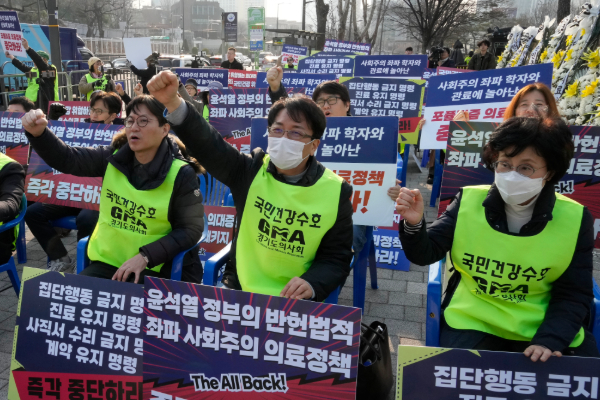South Korea is poised to start suspending the licenses of thousands of striking junior doctors as a punitive measure against their weekslong walkouts that have shaken hospital operations.
Starting next week, the government said it will inform the striking medical interns and residents of its final decision to suspend their licenses for missing a government-imposed February 29 deadline to return to work.
It’s still unclear whether the move will prompt the doctors to end their strikes, and the standoff could still deepen as some senior doctors plan to submit resignations on Monday in a show of solidarity with the junior strikers.
Here are the latest developments on the strikes touched off by the government’s announcement in early February that it would recruit 2,000 more medical students yearly.
Why Are Their Licenses Being Suspended?
Since early March, the South Korean government has been taking a series of administrative steps to suspend the licenses of about 12,000 junior doctors. The steps include informing the strikers about possible suspensions and giving them opportunities to respond.
Vice Health Minister Park Min-soo said Tuesday the government is expected to finish those administrative steps for some of the strikers next week and that it will send them final government notices about their impending license suspensions.
Each notice would contain details including when a license suspension will take effect and how long it will last. By law, they must be delivered in person or by mail. But for those whose addresses are unknown, the suspensions would take effect after related information is posted on the government website, according to the Health Ministry.
Health officials have said each striking doctor could face a minimum three-month license suspension and possible indictment by prosecutors. The country’s medical law allows punishments of medical personnel if they refuse government orders to resume work.
Park repeated his appeal for doctors to report back to work, suggesting those who return would face unspecified softer punishments. He previously warned that junior doctors with suspension records could face delays in getting licenses for specialists or trouble in finding jobs.
What Are The Prospects For Walkouts?
Despite the suspensions, striking doctors won’t likely back down anytime soon as they have already ignored repeated warnings they must return to work or face prosecution.
Some observers have questioned whether the government could suspend all the striking doctors, who represent more than 90% of the country’s 13,000 interns and resident doctors. They said the government would likely target strike leaders and that they would likely respond with legal action.
Further complicating the situation, senior doctors at major university hospitals — where most of the striking doctors trained — are threatening to submit resignations en masse early next week. They plan to continue their work for the time being, but if they walk off the job like the junior doctors, that would cause a much bigger strain on South Korea’s medical services, observers say.
The government urged senior doctors to cancel those plans. It recently sent notices to two senior doctors who lead an emergency committee for the walkouts, telling them their licenses would be suspended for three months for allegedly inciting the junior doctors’ strikes. One of the two doctors, Park Myung-Ha, accused the government of attempting to break up the emergency committee and sending a warning message to the striking junior doctors.
The government on Wednesday announced detailed plans for how to allocate the additional 2,000 admission seats to medical schools, indicating that the government has no intention of revising its plans. The doctors’ emergency committee said in a statement Thursday that the striking doctors “can’t repress our astonishment and anger.”
What Is At Centre Of Dispute?
At the heart of the confrontation is a government plan to increase the country’s medical school enrollment quota by 2,000 starting next year, from the current cap of 3,058, which has been unchanged since 2006.
The government says it needs to add up to 10,000 doctors by 2035 because the country has one of the world’s fastest-aging populations and its doctors-to-population ratio is among the lowest among advanced economies. Officials say more doctors are needed to address a long-running shortage of physicians in low-paying but key essential professions like pediatrics and emergency departments.
But doctors say universities can’t offer quality education to such an abruptly increased number of students and that it would ultimately hurt the quality of South Korea’s medical services. They say doctors in greater competition would likely engage in overtreatment and that newly recruited students would also likely want to work in high-paying, popular professions like plastic surgery and dermatology.
The doctors’ protests haven’t generated public support, with a recent survey showing that about 90% of respondents support an increase in the medical school admission cap. Some critics say the striking doctors worry that adding more doctors would result in lower incomes in the future.
The striking doctors account for less than 10% of the country’s 140,000 doctors. But in some major hospitals, they represent 30-40% of the total doctors and assist senior doctors and deal with inpatients. Their walkouts have subsequently led to hundreds of cancelled or postponed surgeries and other treatments.
Source: AP





